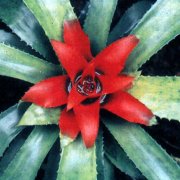Care of the indoor plant Nidularium or Blushing Bromeliad |
|
The genus Nidularium, family Bromeliaceae, includes 50 species of epiphytic plants native to the rainforests of Brazil. Some species are: Nidularium fulgens, Nidularium innocentii, Nidularium atalaiaense, Nidularium billbergioides. Common name: Blushing Bromeliad. They are bromeliads very similar to those of the Neoregelia genus, reaching 30 cm (11.8") in height and 50 cm (19.68") in diameter. The leaves, glossy green or variegated, are arranged in closed rosettes and have serrated margins; the central leaves are smaller and red in color. The flowers are small but surrounded by attractive red, yellow, orange, pink or purple bracts. They bloom in summer; the mother plant dies after flowering but first produces suckers. Blushing Bromeliad is used as indoor and greenhouse plants. It's ideal for rooms with a lot of light but without direct sun. Nidularium needs a filtered light exposure without direct sun. In winter they need a rest at 16-18 ºC (61-64 ºF); it does not resist less than 13 ºC (55.4 ºF). In spring and summer it prefers an average temperature of 24 ºC (75.2 ºF). The soil can be a mixture of peat and substrate for indoor plants in the same proportions. Blushing Bromeliad usually does not need a transplant. Always water with lime-free water so that the substrate never dries out completely; the center of the rosette must always have water. The humidity must be high: regularly spray the leaves with lime-free water and place a plate with damp stones under the pot. Fertilize in spring and summer every 3 weeks with low calcium mineral fertilizer. Eliminate wilted flowers but keep bracts. Nidularium is attacked by mealybugs if the humidity is low; it's sensitive to direct sun and cold. Blushing Bromeliad is easily propagated by division of the suckers in the first half of spring. |
Images of the indoor plant Nidularium or Blushing Bromeliad |
Find plants
Nidularium or Blushing Bromeliad | Care and Growing
© 2025 FavThemes
